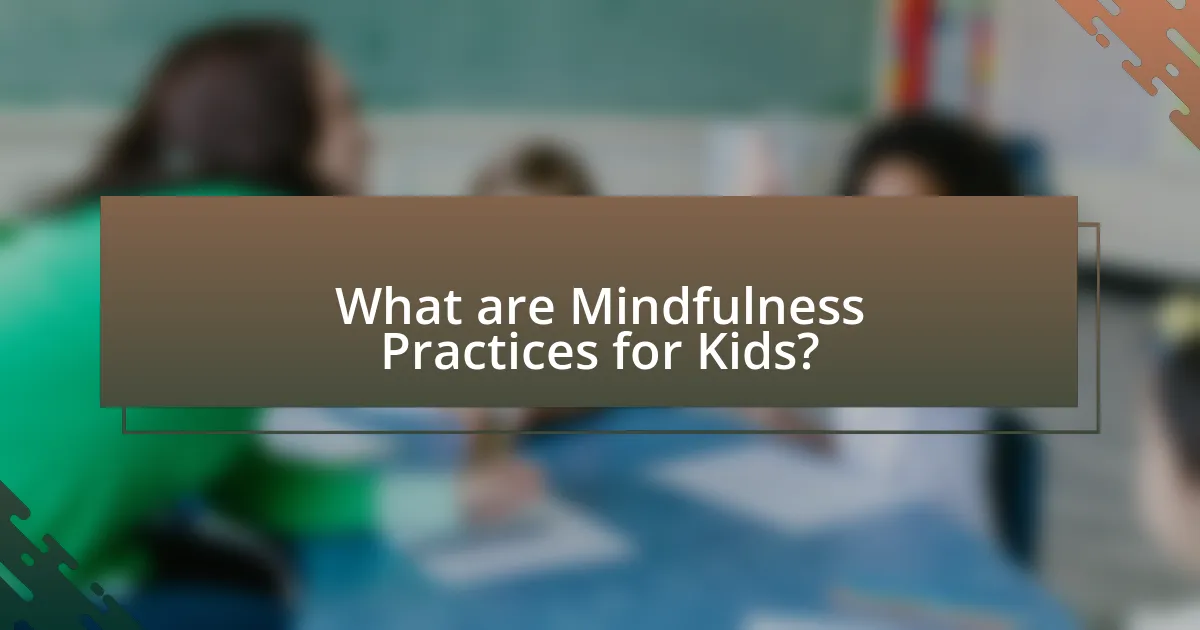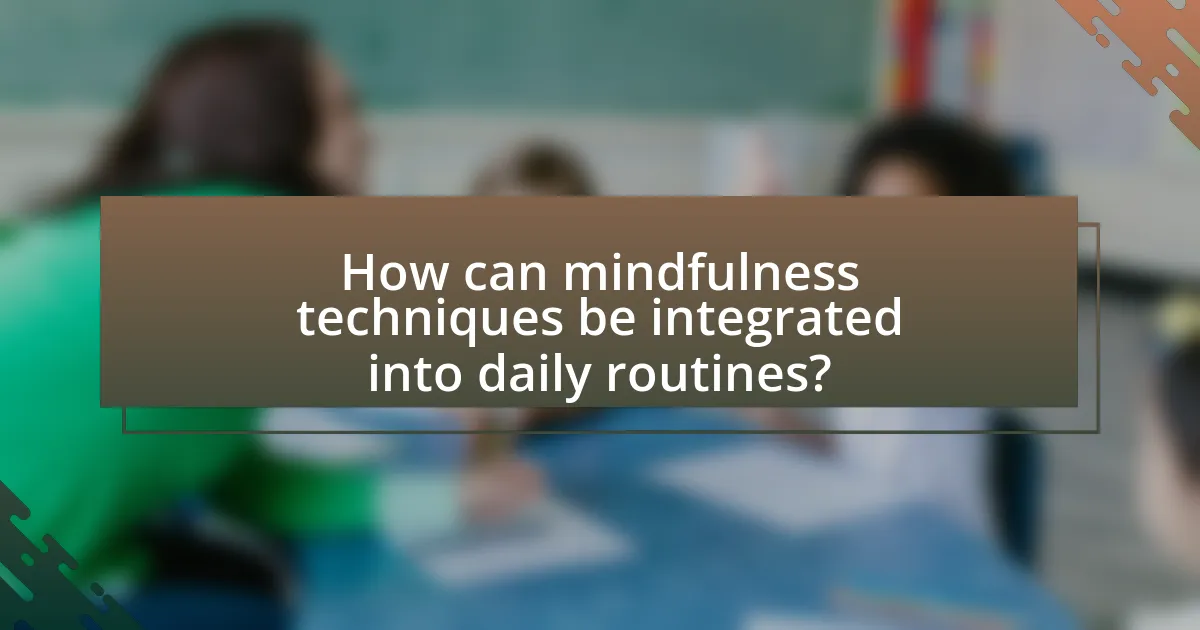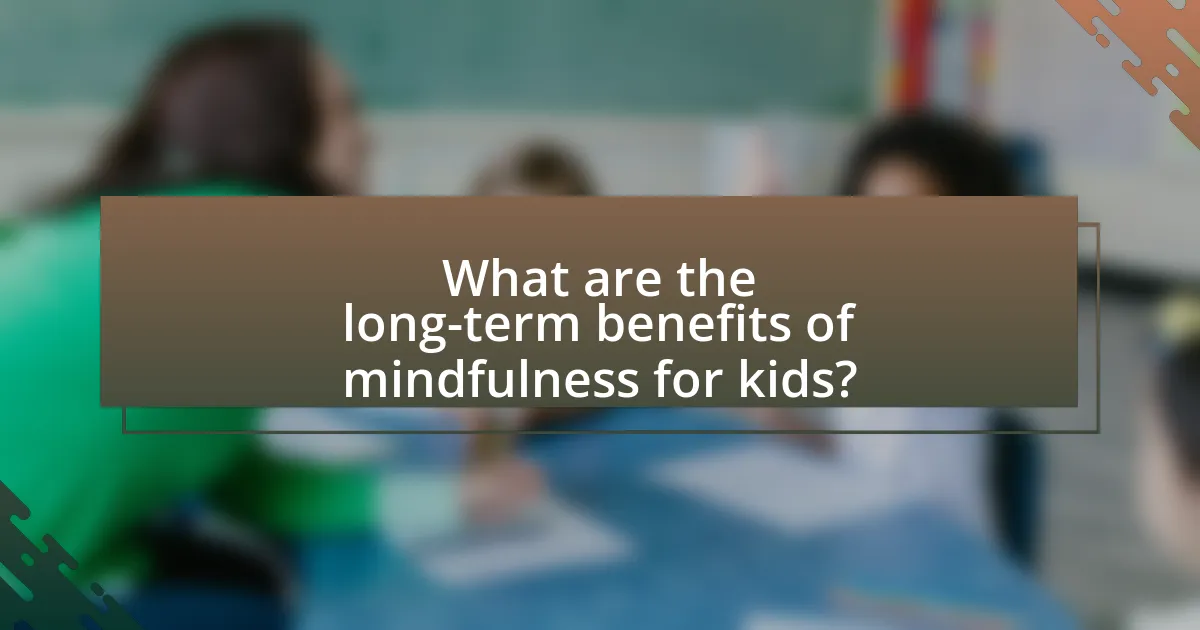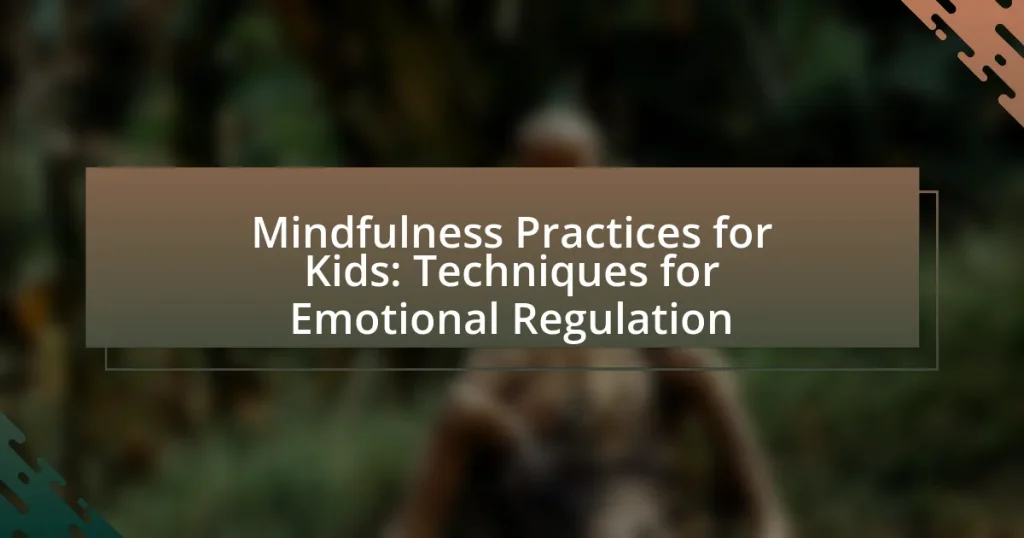Mindfulness practices for kids encompass techniques such as deep breathing, body scans, and guided imagery, aimed at enhancing emotional regulation and overall well-being. Research indicates that these practices can significantly reduce anxiety, improve attention, and foster emotional resilience in children. The article explores the benefits of mindfulness for emotional regulation, specific emotional challenges it addresses, and suitable practices for different age groups. Additionally, it discusses the importance of emotional regulation for social interactions and academic performance, as well as practical strategies for parents and educators to implement mindfulness in daily routines and school settings.

What are Mindfulness Practices for Kids?
Mindfulness practices for kids include techniques such as deep breathing, body scans, and guided imagery. These practices help children develop emotional regulation by promoting awareness of their thoughts and feelings. Research indicates that mindfulness can enhance attention, reduce anxiety, and improve overall well-being in children. For instance, a study published in the journal “Mindfulness” by Zoogman et al. (2015) found that mindfulness interventions significantly improved emotional regulation and social skills among children.
How do mindfulness practices benefit children’s emotional regulation?
Mindfulness practices benefit children’s emotional regulation by enhancing their ability to recognize and manage their emotions. These practices, such as deep breathing and focused attention, help children develop greater self-awareness and emotional control. Research indicates that children who engage in mindfulness activities show improved emotional regulation skills, leading to reduced anxiety and better coping strategies in stressful situations. A study published in the journal “Mindfulness” by Zoogman et al. (2015) found that mindfulness interventions significantly improved emotional regulation among children, demonstrating the effectiveness of these practices in fostering emotional resilience.
What specific emotional challenges can mindfulness help address in kids?
Mindfulness can help address specific emotional challenges in kids, including anxiety, stress, and emotional dysregulation. Research indicates that mindfulness practices can reduce anxiety levels by promoting relaxation and enhancing emotional awareness, which allows children to better manage their feelings. A study published in the journal “Mindfulness” by Zoogman et al. (2015) found that mindfulness interventions significantly decreased anxiety and stress in children, demonstrating the effectiveness of these practices in fostering emotional resilience. Additionally, mindfulness helps improve attention and focus, which can further aid in emotional regulation by allowing children to pause and respond thoughtfully to their emotions rather than react impulsively.
How does mindfulness contribute to overall mental health in children?
Mindfulness significantly contributes to overall mental health in children by enhancing emotional regulation and reducing anxiety. Research indicates that mindfulness practices, such as meditation and focused breathing, help children develop greater awareness of their thoughts and feelings, leading to improved self-control and resilience. A study published in the journal “Mindfulness” by Zoogman et al. (2015) found that children who engaged in mindfulness training exhibited lower levels of stress and anxiety, as well as improved attention and emotional well-being. This evidence supports the notion that incorporating mindfulness into children’s routines can foster healthier mental states and coping mechanisms.
What types of mindfulness practices are suitable for kids?
Mindfulness practices suitable for kids include breathing exercises, guided imagery, body scans, and mindful movement activities like yoga. Breathing exercises help children focus on their breath, promoting relaxation and awareness. Guided imagery allows kids to visualize calming scenes, enhancing their ability to manage stress. Body scans encourage children to pay attention to different parts of their body, fostering a connection between mind and body. Mindful movement activities, such as yoga, combine physical activity with mindfulness, improving emotional regulation and concentration. Research indicates that these practices can significantly reduce anxiety and improve emotional well-being in children, making them effective tools for emotional regulation.
What are some simple mindfulness exercises for young children?
Some simple mindfulness exercises for young children include deep breathing, body scanning, and mindful listening. Deep breathing involves children taking slow, deep breaths while counting to four, which helps them focus and calm their minds. Body scanning encourages children to pay attention to different parts of their bodies, promoting awareness and relaxation. Mindful listening can be practiced by having children listen to sounds around them, such as birds chirping or leaves rustling, enhancing their ability to concentrate and be present. These exercises are effective in helping children develop emotional regulation skills and improve their overall well-being.
How can older children engage in mindfulness practices effectively?
Older children can engage in mindfulness practices effectively by incorporating structured activities such as guided meditation, breathing exercises, and mindful movement. These activities help them focus their attention, reduce stress, and enhance emotional regulation. Research indicates that mindfulness practices can lead to improved attention spans and emotional resilience in children, as evidenced by a study published in the Journal of Child Psychology and Psychiatry, which found that children who participated in mindfulness programs showed significant reductions in anxiety and behavioral issues. By regularly practicing these techniques, older children can develop a greater awareness of their thoughts and feelings, leading to better emotional management.
Why is emotional regulation important for children?
Emotional regulation is important for children because it enables them to manage their emotions effectively, leading to better social interactions and academic performance. Children who can regulate their emotions are less likely to engage in disruptive behaviors and more likely to develop positive relationships with peers and adults. Research indicates that emotional regulation skills are linked to improved mental health outcomes, as children who struggle with emotional regulation are at a higher risk for anxiety and depression. Furthermore, studies show that children with strong emotional regulation skills tend to perform better academically, as they can focus and engage more fully in learning environments.
How does emotional regulation impact a child’s social interactions?
Emotional regulation significantly enhances a child’s social interactions by enabling them to manage their emotions effectively. When children can regulate their emotions, they are better equipped to respond appropriately in social situations, leading to improved communication and relationship-building skills. Research indicates that children with strong emotional regulation skills are more likely to engage in positive social behaviors, such as sharing and cooperating, while also being less prone to aggressive or disruptive behaviors. For instance, a study published in the Journal of Abnormal Child Psychology found that children who practiced emotional regulation techniques demonstrated better peer relationships and social competence compared to those who struggled with emotional control.
What role does emotional regulation play in academic performance?
Emotional regulation significantly influences academic performance by enabling students to manage their emotions effectively, which in turn enhances focus, motivation, and resilience in learning environments. Research indicates that students with strong emotional regulation skills tend to achieve higher grades and demonstrate better problem-solving abilities, as they can navigate stress and anxiety more effectively. For instance, a study published in the Journal of Educational Psychology found that students who practiced emotional regulation techniques, such as mindfulness, showed improved academic outcomes and reduced test anxiety, highlighting the direct correlation between emotional management and academic success.
How can parents and educators implement mindfulness practices?
Parents and educators can implement mindfulness practices by incorporating structured activities such as guided meditation, breathing exercises, and mindful observation into daily routines. Research indicates that these practices can enhance emotional regulation and reduce stress among children. For instance, a study published in the journal “Mindfulness” by Zenner, Herrnleben-Kurz, and Walach (2014) found that mindfulness training significantly improved emotional regulation in school-aged children. By dedicating specific times for mindfulness activities, such as during morning meetings or after recess, parents and educators can create a supportive environment that fosters emotional awareness and resilience.
What are the challenges in teaching mindfulness to kids?
Teaching mindfulness to kids presents several challenges, including their limited attention spans and difficulty in understanding abstract concepts. Children often struggle to focus for extended periods, making it hard for them to engage in mindfulness practices that require sustained attention. Additionally, the abstract nature of mindfulness can be challenging for kids to grasp, as they may find it difficult to relate to concepts like being present or observing thoughts without judgment. Research indicates that children aged 5 to 12 typically have shorter attention spans, averaging around 10 to 20 minutes, which complicates the implementation of mindfulness exercises that are often longer in duration. Furthermore, varying developmental stages among children can lead to inconsistent engagement and comprehension levels, making it essential for educators to tailor mindfulness practices to suit different age groups and individual needs.

How can mindfulness techniques be integrated into daily routines?
Mindfulness techniques can be integrated into daily routines by incorporating short, focused practices into common activities. For example, parents can encourage children to practice mindful breathing for a few minutes during transitions, such as before meals or bedtime. Research indicates that even brief mindfulness exercises can enhance emotional regulation and reduce anxiety in children, as shown in a study published in the journal “Mindfulness” by authors Khalsa et al. (2015), which found that regular mindfulness practice significantly improved emotional awareness and self-regulation among participants. Additionally, integrating mindfulness into playtime, such as through mindful observation of nature or engaging in mindful eating, can further reinforce these techniques in a child’s daily life.
What are effective strategies for incorporating mindfulness into school settings?
Effective strategies for incorporating mindfulness into school settings include implementing structured mindfulness programs, integrating mindfulness practices into the daily curriculum, and providing training for teachers. Structured programs, such as Mindfulness-Based Stress Reduction (MBSR) or Mindfulness-Based Cognitive Therapy (MBCT), have been shown to improve students’ emotional regulation and reduce anxiety, as evidenced by a study published in the Journal of School Psychology, which found that students participating in mindfulness programs reported lower stress levels and improved focus. Integrating short mindfulness exercises, such as breathing techniques or guided meditations, into classroom routines can enhance students’ attention and emotional awareness. Additionally, training teachers in mindfulness practices equips them to model these techniques, fostering a supportive environment for students to develop their own mindfulness skills.
How can teachers create a mindful classroom environment?
Teachers can create a mindful classroom environment by incorporating mindfulness practices into daily routines. This can include starting each day with a short meditation or breathing exercise, which has been shown to enhance focus and reduce anxiety among students. Research indicates that mindfulness practices can lead to improved emotional regulation and academic performance, as evidenced by a study published in the Journal of Educational Psychology, which found that students who participated in mindfulness programs exhibited greater emotional resilience and better attention control. Additionally, creating a calm and organized physical space, using soft lighting, and incorporating nature elements can further promote mindfulness, allowing students to feel safe and centered.
What activities can be used to promote mindfulness during school hours?
Activities that can promote mindfulness during school hours include guided meditation, mindful breathing exercises, and yoga sessions. Guided meditation helps students focus their thoughts and reduce anxiety, while mindful breathing exercises encourage awareness of the present moment, improving concentration. Yoga sessions integrate physical movement with mindfulness, enhancing emotional regulation and reducing stress. Research indicates that these practices can lead to improved attention and emotional well-being among students, as evidenced by a study published in the Journal of Educational Psychology, which found that mindfulness interventions significantly increased students’ focus and reduced behavioral issues.
How can parents encourage mindfulness at home?
Parents can encourage mindfulness at home by integrating mindfulness practices into daily routines. This can include setting aside specific times for mindfulness activities, such as guided meditation or deep breathing exercises, which have been shown to reduce stress and improve emotional regulation in children. Research indicates that regular mindfulness practice can enhance attention and emotional resilience, as noted in a study published in the Journal of Child Psychology and Psychiatry by authors like Zoë A. K. H. H. van der Oord. Additionally, parents can model mindfulness by demonstrating present-moment awareness during family interactions, thereby reinforcing the importance of being mindful in everyday life.
What daily routines can be adapted to include mindfulness practices?
Daily routines that can be adapted to include mindfulness practices encompass activities such as morning rituals, mealtime, and bedtime routines. For instance, during morning rituals, individuals can practice mindful breathing or gratitude exercises to set a positive tone for the day. Mealtime can be transformed into a mindful eating experience by focusing on the taste, texture, and aroma of food, which enhances awareness and appreciation of nourishment. Bedtime routines can incorporate mindfulness through guided meditation or reflection on the day’s events, promoting relaxation and emotional regulation. Research indicates that integrating mindfulness into daily routines can significantly improve emotional regulation and reduce anxiety in children, as highlighted in the study “Mindfulness-Based Interventions for Children and Adolescents: A Systematic Review” published in the journal “Child and Adolescent Mental Health” by authors Zoë A. M. H. van der Oord, et al.
How can family activities promote mindfulness together?
Family activities can promote mindfulness together by encouraging shared experiences that foster present-moment awareness and emotional connection. Engaging in activities such as cooking, gardening, or playing games allows family members to focus on the task at hand, enhancing their ability to be mindful. Research indicates that mindfulness practices can improve emotional regulation, which is crucial for children’s development. For instance, a study published in the Journal of Child and Family Studies found that family mindfulness practices significantly reduced stress and improved emotional well-being among children and parents alike. This evidence supports the idea that participating in mindful family activities can cultivate a supportive environment for emotional regulation.

What are the long-term benefits of mindfulness for kids?
The long-term benefits of mindfulness for kids include improved emotional regulation, enhanced focus, and better social skills. Research indicates that practicing mindfulness can lead to a significant reduction in anxiety and stress levels, which contributes to overall mental well-being. A study published in the journal “Mindfulness” by Zoogman et al. (2015) found that children who engaged in mindfulness practices showed increased attention spans and better emotional control over time. Additionally, mindfulness fosters empathy and compassion, which are crucial for developing healthy relationships. These benefits collectively support children’s academic performance and social interactions, making mindfulness a valuable practice for their long-term development.
How does mindfulness influence resilience in children?
Mindfulness enhances resilience in children by promoting emotional regulation and reducing stress. Research indicates that mindfulness practices, such as meditation and focused breathing, help children develop greater awareness of their thoughts and feelings, enabling them to respond to challenges more effectively. A study published in the journal “Mindfulness” by Zoogman et al. (2015) found that children who engaged in mindfulness training showed significant improvements in emotional regulation and resilience compared to those who did not participate in such practices. This ability to manage emotions and stress contributes to a child’s overall resilience, allowing them to cope better with adversity and bounce back from setbacks.
What evidence supports the effectiveness of mindfulness in improving emotional regulation?
Mindfulness has been shown to effectively improve emotional regulation, as evidenced by various studies. For instance, a meta-analysis conducted by Khoury et al. (2015) found that mindfulness-based interventions significantly reduce emotional dysregulation and enhance emotional awareness across diverse populations. Additionally, research by Zeidan et al. (2010) demonstrated that even brief mindfulness training can lead to improvements in emotional regulation, as participants reported decreased anxiety and increased positive affect. These findings collectively support the notion that mindfulness practices can be a valuable tool for enhancing emotional regulation in individuals, including children.
How can mindfulness practices lead to better coping strategies in the future?
Mindfulness practices can lead to better coping strategies in the future by enhancing emotional awareness and regulation. Engaging in mindfulness helps individuals, particularly children, develop the ability to observe their thoughts and feelings without judgment, which fosters resilience in stressful situations. Research indicates that mindfulness training can significantly reduce anxiety and improve emotional regulation skills, as evidenced by a study published in the journal “Child Development” by Zoogman et al. (2015), which found that mindfulness interventions led to improved emotional well-being and coping mechanisms among children. This foundational skill set enables individuals to approach challenges with a calmer mindset, ultimately leading to more effective coping strategies in various life situations.
What are some practical tips for starting mindfulness practices with kids?
To start mindfulness practices with kids, incorporate simple activities like deep breathing, guided imagery, and mindful observation. These activities help children focus on the present moment and develop emotional regulation skills. For instance, deep breathing exercises can be introduced by having kids inhale deeply through their noses and exhale slowly through their mouths, which has been shown to reduce anxiety and improve focus. Additionally, using guided imagery, where children visualize a peaceful scene, can enhance relaxation and emotional awareness. Mindful observation can be practiced by encouraging kids to notice their surroundings, such as the colors of leaves or the sounds of nature, fostering a sense of connection to the present. These techniques are effective as they are age-appropriate and can be easily integrated into daily routines, making mindfulness accessible and engaging for children.
